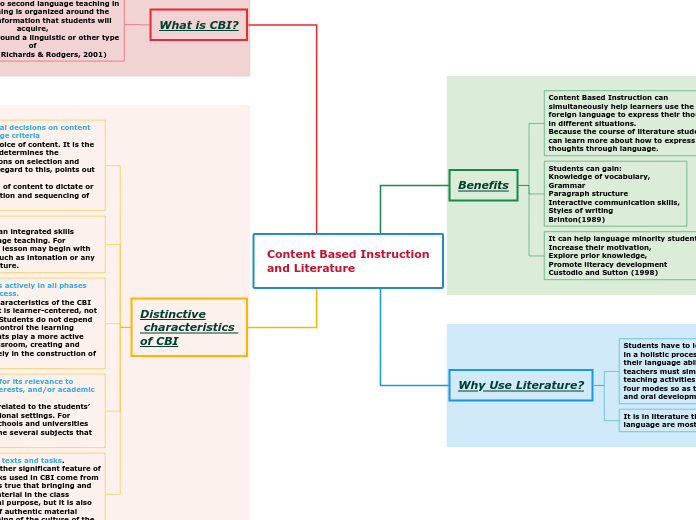Content Based Instruction
and Literature
Benefits
Content Based Instruction can simultaneously help learners use the foreign language to express their thoughts in different situations.
Because the course of literature students can learn more about how to express their thoughts through language.
Students can gain:
Knowledge of vocabulary,
Grammar
Paragraph structure
Interactive communication skills,
Styles of writing
Brinton(1989)
It can help language minority students:
Increase their motivation,
Explore prior knowledge,
Promote literacy development
Custodio and Sutton (1998)
Why Use Literature?
Students have to learn the foreign language in a holistic process in order to increase their language ability. As a result, FL teachers must simultaneously apply teaching activities that tend to combine the four modes so as to enhance both literacy and oral development.
It is in literature that "the resources of the language are most fully and skillfully used"
What is CBI?
“Content-Based Instruction refers to
an approach to second language teaching in
which teaching is organized around the content or information that students will acquire,
rather than around a linguistic or other type of
syllabus” (Richards & Rodgers, 2001)
Distinctive
characteristics
of CBI
1. Base instructional decisions on content rather than language criteria
CBI permits the choice of content. It is the content itself that determines the pedagogical decisions on selection and sequencing. With regard to this, points out that CBI
“allows the choice of content to dictate or influence the selection and sequencing of language items”
2. Integrate skills.
CBI advocates for an integrated skills approach to language teaching. For example, a regular lesson may begin with any skill or focus such as intonation or any other linguistic feature.
3. Involve students actively in all phases
of the learning process.
One of the main characteristics of the CBI classroom is that it is learner-centered, not
teacher-centered. Students do not depend on the teacher to control the learning experience. Students play a more active role in the CBI classroom, creating and participating actively in the construction of knowledge.
4. Choose content for its relevance to
students’ lives, interests, and/or academic goals.
Content is closely related to the students’ needs and instructional settings. For instance, in high schools and universities content parallels the several subjects that learners study.
5. Select authentic texts and tasks.
Authenticity is another significant feature of CBI. Texts and tasks used in CBI come from the real world. It is true that bringing and using authentic material in the class modifies its original purpose, but it is also true that the use of authentic material promotes the learning of the culture of the target language.
